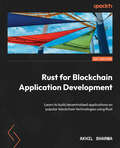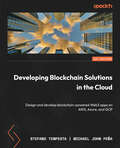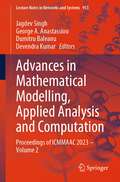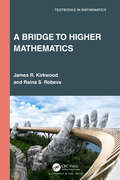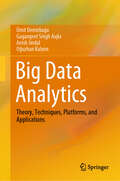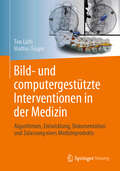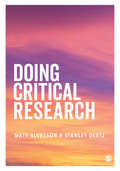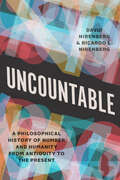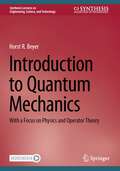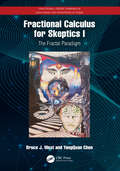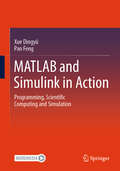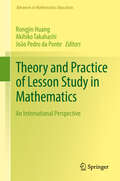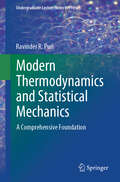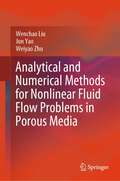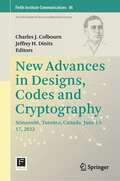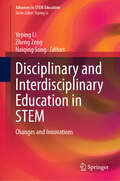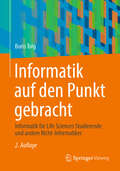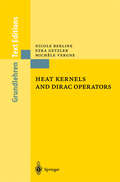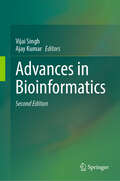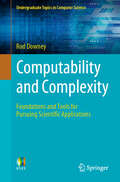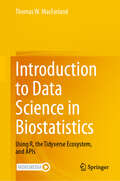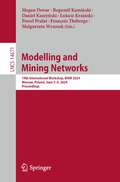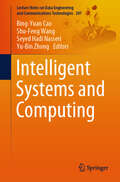- Table View
- List View
Rust For Blockchain Application Development: Learn To Build Decentralized Applications On Popular Blockchain Technologies Using Rust
by Akhil SharmaLearn to build decentralized applications on popular blockchain technologies using Rust
Developing Blockchain Solutions in the Cloud: Design And Develop Blockchain-powered Web3 Apps On Aws, Azure, And Gcp
by Stefano Tempesta and Michael John PeñaDesign and develop blockchain-powered Web3 apps on AWS, Azure, and GCP
Advances in Mathematical Modelling, Applied Analysis and Computation: Proceedings of ICMMAAC 2023 – Volume 2 (Lecture Notes in Networks and Systems #953)
by Jagdev Singh George A. Anastassiou Dumitru Baleanu Devendra KumarThis book gathers selected research articles presented in the “6th International Conference on Mathematical Modelling, Applied Analysis and Computation (ICMMAAC)”, held at JECRC University, Jaipur, during August 3–5, 2023. This book is focused on articles dealing with necessary theory and techniques in a balanced manner, and contributes towards solving mathematical problems arising in physics, engineering, chemistry, biological systems, medicine, networking system, control systems, environmental sciences, social issues of current interest and more. Annually held since 2018, the ICMMAAC conference aimed, in particular, to foster cooperation among practitioners and theoreticians in these fields. This proceedings is an invaluable resource for researchers, academicians and professionals associated or interested in current advances in different aspects of mathematical modelling, computational algorithms and analysis necessary for handling real-world problems.
A Bridge to Higher Mathematics (Textbooks in Mathematics)
by James R. Kirkwood Raina S. RobevaThe goal of this unique text is to provide an “experience” that would facilitate a better transition for mathematics majors to the advanced proof-based courses required for their major.If you feel like you love mathematics but hate proofs, this book is for you. The change from example-based courses such as Introductory Calculus to the proof-based courses in the major is often abrupt, and some students are left with the unpleasant feeling that a subject they loved has turned into material they find hard to understand.The book exposes students and readers to some fundamental content and essential methods of constructing mathematical proofs in the context of four main courses required for the mathematics major – probability, linear algebra, real analysis, and abstract algebra.Following an optional foundational chapter on background material, four short chapters, each focusing on a particular course, provide a slow-paced but rigorous introduction. Students get a preview of the discipline, its focus, language, mathematical objects of interest, and methods of proof commonly used in the field. The organization of the book helps to focus on the specific methods of proof and main ideas that will be emphasized in each of the courses.The text may also be used as a review tool at the end of each course and for readers who want to learn the language and scope of the broad disciplines of linear algebra, abstract algebra, real analysis, and probability, before transitioning to these courses.
A Bridge to Higher Mathematics (Textbooks in Mathematics)
by James R. Kirkwood Raina S. RobevaThe goal of this unique text is to provide an “experience” that would facilitate a better transition for mathematics majors to the advanced proof-based courses required for their major.If you feel like you love mathematics but hate proofs, this book is for you. The change from example-based courses such as Introductory Calculus to the proof-based courses in the major is often abrupt, and some students are left with the unpleasant feeling that a subject they loved has turned into material they find hard to understand.The book exposes students and readers to some fundamental content and essential methods of constructing mathematical proofs in the context of four main courses required for the mathematics major – probability, linear algebra, real analysis, and abstract algebra.Following an optional foundational chapter on background material, four short chapters, each focusing on a particular course, provide a slow-paced but rigorous introduction. Students get a preview of the discipline, its focus, language, mathematical objects of interest, and methods of proof commonly used in the field. The organization of the book helps to focus on the specific methods of proof and main ideas that will be emphasized in each of the courses.The text may also be used as a review tool at the end of each course and for readers who want to learn the language and scope of the broad disciplines of linear algebra, abstract algebra, real analysis, and probability, before transitioning to these courses.
Big Data Analytics: Theory, Techniques, Platforms, and Applications
by Ümit Demirbaga Gagangeet Singh Aujla Anish Jindal Oğuzhan KalyonThis book introduces readers to big data analytics. It covers the background to and the concepts of big data, big data analytics, and cloud computing, along with the process of setting up, configuring, and getting familiar with the big data analytics working environments in the first two chapters. The third chapter provides comprehensive information on big data processing systems - from installing these systems to implementing real-world data applications, along with the necessary codes. The next chapter dives into the details of big data storage technologies, including their types, essentiality, durability, and availability, and reveals their differences in their properties. The fifth and sixth chapters guide the reader through understanding, configuring, and performing the monitoring and debugging of big data systems and present the available commercial and open-source tools for this purpose. Chapter seven gives information about a trending machine learning, Bayesian network: a probabilistic graphical model, by presenting a real-world probabilistic application to understand causal, complex, and hidden relationships for diagnosis and forecasting in a scalable manner for big data. Special sections throughout the eighth chapter present different case studies and applications to help the readers to develop their big data analytics skills using various big data analytics frameworks.The book will be of interest to business executives and IT managers as well as university students and their course leaders, in fact all those who want to get involved in the big data world.
Bild- und computergestützte Interventionen in der Medizin: Algorithmen, Entwicklung, Dokumentation und Zulassung eines Medizinprodukts
by Tim Christian Lüth Mattias Felix TrägerDieses Buch richtet sich an Ingenieure, Informatiker sowie interessierte Angehörige der medizinischen und pflegerischen Berufe. Es erklärt die Grundlagen und Anwendungen der computerassistierten- und robotergestützten Medizingeräte auf dem aktuellen Stand der Technik. Derartige Systeme haben in den letzten 20 Jahren revolutionäre positive Veränderungen in der Radiologie, bei Interventionen und in vielen Gebieten der Chirurgie bewirkt. Mit dieser Technik ist es möglich, Bilddaten aus unterschiedlichen bildgebenden Systemen – wie z.B. Computertomograph, Ultraschall-gerät oder Videoendoskop – zu fusionieren, am Bildschirm dreidimensional darzustellen und darin mit dem Computer Eingriffe zu planen. Während der Operation wird die räumliche Lage des navigierten Instruments gemessen und im 3D-Modell des Patienten am Bildschirm dargestellt. Geplante Pfade der Instrumente werden eingeblendet, es wird vor Risiken bei Abweichungen von der Planung gewarnt und es können aktive Instrumente wie Bohrer, Fräser, Laser oder sogar Roboter automatisiert gesteuert werden. Die Autoren sind auf diesem Gebiet seit über 25 Jahren sowohl wissenschaftlich als auch unternehmerisch international führend tätig, weshalb in diesem Buch auch Entwicklungsmethodik, Dokumentation, Zulassung und Inverkehrbringung als Medizinprodukt praxisnah erläutert werden.
Doing Critical Research (Sage Series In Management Research Ser.)
by Mats Alvesson Stanley DeetzThis title builds on the success of Doing Critical Management Research which has proven to be a seminal text in the 20 years since publication. In 2020, Alvesson and Deetz have broadened their focus and updated the original book to offer relevance to critical research across all of the social sciences. In reflecting contemporary theoretical and methodological turns over the past few decades, it includes coverage of key contemporary topics such as race, gender, postmodernism and intersectionality. With examples throughout, the authors provide an authoritative and insightful framework for navigating critical theories and methods and sets out a new agenda for critical research undertaken today.
Doing Critical Research (Sage Series In Management Research Ser.)
by Mats Alvesson Stanley DeetzThis title builds on the success of Doing Critical Management Research which has proven to be a seminal text in the 20 years since publication. In 2020, Alvesson and Deetz have broadened their focus and updated the original book to offer relevance to critical research across all of the social sciences. In reflecting contemporary theoretical and methodological turns over the past few decades, it includes coverage of key contemporary topics such as race, gender, postmodernism and intersectionality. With examples throughout, the authors provide an authoritative and insightful framework for navigating critical theories and methods and sets out a new agenda for critical research undertaken today.
Uncountable: A Philosophical History of Number and Humanity from Antiquity to the Present
by David Nirenberg Ricardo L. NirenbergRanging from math to literature to philosophy, Uncountable explains how numbers triumphed as the basis of knowledge—and compromise our sense of humanity. Our knowledge of mathematics has structured much of what we think we know about ourselves as individuals and communities, shaping our psychologies, sociologies, and economies. In pursuit of a more predictable and more controllable cosmos, we have extended mathematical insights and methods to more and more aspects of the world. Today those powers are greater than ever, as computation is applied to virtually every aspect of human activity. Yet, in the process, are we losing sight of the human? When we apply mathematics so broadly, what do we gain and what do we lose, and at what risk to humanity? These are the questions that David and Ricardo L. Nirenberg ask in Uncountable, a provocative account of how numerical relations became the cornerstone of human claims to knowledge, truth, and certainty. There is a limit to these number-based claims, they argue, which they set out to explore. The Nirenbergs, father and son, bring together their backgrounds in math, history, literature, religion, and philosophy, interweaving scientific experiments with readings of poems, setting crises in mathematics alongside world wars, and putting medieval Muslim and Buddhist philosophers in conversation with Einstein, Schrödinger, and other giants of modern physics. The result is a powerful lesson in what counts as knowledge and its deepest implications for how we live our lives.
Introduction to Quantum Mechanics: With a Focus on Physics and Operator Theory (Synthesis Lectures on Engineering, Science, and Technology)
by Horst R. BeyerThis book presents an introduction to quantum mechanics that consistently uses the methods of operator theory, allowing readers to develop a physical understanding of quantum mechanical systems. The methods of operator theory are discussed throughout the book and presented with a mathematically rigorous approach. The author describes in detail how to use the methods of operator theory for analyzing quantum mechanical systems, starting with the definition of the involved physical operators (observables) up to the calculation of their spectra, spectral measures, and functional calculus. In addition, the book includes the construction of exponential functions of the involved Hamilton operators that solve the problem of time evolution.
Fractional Calculus for Skeptics I: The Fractal Paradigm (Fractional Order Thinking in Exploring the Frontiers of STEM)
by Bruce J. West YangQuan ChenThis book is the first of its kind on fractional calculus (FC), dedicated to advocating for FC in STEM education and research.Fractional calculus is increasingly used today, but there remains a core population of skeptics regarding the utility of this "new" calculus. This book is intended for those who are skeptical about the need for fractional calculus to describe dynamic complex networks and must be convinced of its use on a case-by-case basis. It is a one-stop resource to rapidly read and replace the appropriate skepticism with new knowledge. It offers compelling reasons from the perspectives of the physical, social, and life sciences as to why fractional calculus is needed when addressing the complexity of an underlying STEM phenomenon. The six chapters are accompanied by useful and essential appendices and chapter-end references. Each includes new (fractional-order) ways of thinking about statistics, complexity dynamics, and what constitutes a solution to a complexity science problem.The book will appeal to students and researchers in all STEM-related fields, such as engineering, physics, biology and biomedicine, climate change, big data, and machine learning. It is also suitable for general readers interested in these fields.
MATLAB and Simulink in Action: Programming, Scientific Computing and Simulation
by Dingyü Xue Feng PanThe textbook is intended for teaching MATLAB language and its applications. The book is composed of three parts: MATLAB programming, scientific computing with MATLAB, and system simulation with Simulink. Since MATLAB is widely used in all fields of science and engineering, a good introduction to the language can not only help students learn how to use it to solve practical problems, but also provide them with the skills to use MATLAB independently in their later courses and research. The three parts of the book are well-balanced and tailored to the needs of engineering students, and the mathematical problems commonly encountered in engineering can be easily solved using MATLAB. This textbook is suitable for undergraduate and graduate students majoring in science and engineering.
Theory and Practice of Lesson Study in Mathematics: An International Perspective (Advances in Mathematics Education)
by Rongjin Huang Akihiko Takahashi João Pedro da PonteThis book brings together and builds on the current research efforts on adaptation, conceptualization, and theorization of Lesson Study (LS). It synthesizes and illustrates major perspectives for theorizing LS and enriches the conceptualization of LS by interpreting the activity as it is used in Japan and China from historical and cultural perspectives. Presenting the practices and theories of LS with practicing teachers and prospective teachers in more than 10 countries, it enables the reader to take a comparative perspective. Finally, the book presents and discusses studies on key aspects of LS such as lesson planning, post-lesson discussion, guiding theories, connection between research and practice, and upscaling.Lesson Study, which has originated in Asia as a powerful effective professional development model, has spread globally. Although the positive effects of lesson study on teacher learning, student learning, and curriculum reforms have been widely documented,conceptualization of and research on LS have just begun to emerge. This book, including 38 chapters contributed by 90 scholars from 21 countries, presents a truly international collaboration on research on and adaptation of LS, and significantly advances the development of knowledge about this process.Chapter 15: "How Variance and Invariance Can Inform Teachers’ Enactment of Mathematics Lessons" of this book is available open access under a CC BY 4.0 license at link.springer.comTheory and Practice of Lesson Study in Mathematics: An International Perspective shows that the power of Lesson Study to transform the role of teachers in classroom research cannot be explained by a simple replication model. Here we see Lesson Study being successful internationally when its key principles and practices are taken seriously and are adapted to meet local issues and challenges. (Max Stephens, Senior research fellow at TheUniversity of Melbourne)It works. Instruction improves, learning improves. Wide scale? Enduring? Deep impact? Lesson study has it. When something works as well as lesson study does, while alternative systems for improving instruction fail, or only succeed on small scale or evaporate as quickly as they show promise, it is time to understand how and why lesson study works. This volume brings the research on lesson study together from around the world. Here is what we already know and here is the way forward for research and practice informed by research. It is time to wake up and pay attention to what has worked so well, on wide scale for so long.(Phil Dara, A leading author of the Common Core State Standards of Mathematics in the U.S.)
Modern Thermodynamics and Statistical Mechanics: A Comprehensive Foundation (Undergraduate Lecture Notes in Physics)
by Ravinder R. PuriThis undergraduate-level textbook offers a unique and in-depth approach to the study of thermodynamics and statistical mechanics. It covers the fundamentals of thermodynamics using both traditional and postulatory approaches, including origin of the concept of thermodynamic entropy, Euler’s equation, Gibbs-Duhem relations, stability of equilibrium, and the concept of thermodynamic potentials, and that of independent thermodynamic observables. The book then delves into the microscopic foundation of thermodynamics, starting with the kinetic theory and highlighting its historical development. Boltzmann's concept of entropy is explored, along with its applications in deriving Planck’s, Bose’s, Bose-Einstein, and Fermi-Dirac distribution functions. The formal structure of classical and quantum statistical mechanics is built based on the concept of statistical entropy and the maximum entropy principle and used to investigate in detail the thermodynamic properties of ideal classical and quantum systems. The book also covers phase transitions, simple theory of critical phenomena, and the theory of interacting van der Waals gases. Throughout the text, the book provides historical context, enriching the reader's understanding. This textbook is a valuable resource for undergraduate physics students, offering comprehensive coverage, including overlooked topics, and a historical perspective on thermodynamics and statistical mechanics.
Analytical and Numerical Methods for Nonlinear Fluid Flow Problems in Porous Media
by Wenchao Liu Jun Yao Weiyao ZhuThis book investigates in detail the mathematical methods and computation methods in efficient solution of some open nonlinear seepage flow problems involved in engineering problems. Developed engineering technologies and some relevant practical field applications are also provided. The introduced open nonlinear problems include nonlinear quadratic pressure gradient term problem, compressible gas seepage flow problem and low-velocity non-Darcy seepage flow problem. Studies on these nonlinear seepage flow problems have attracted engineers and scientists from various disciplines, such as geo-energy engineering, civil and environmental engineering, fluid mechanics, applied mathematics and computation. In particular, the book systematically establishes a fundamental theory for a strongly nonlinear problem of low-velocity non-Darcy seepage flow from a new perspective of moving boundary, while emphasizing the usage of mathematical linearization transformation methods and computational methods into the analytical and numerical solution of the strongly nonlinear partial differential equations. Sufficient knowledge of mathematics is always introduced ahead of model solution to assist readers. And the procedure of strict formula deduction in the model solution process is provided in detail. High-solution figures and tables from model solution are rich in the book. Therefore, it is very helpful for the readers to master the nonlinear model solution methods and engineering technologies. The book is intended for upper undergraduate students and graduate students who are interested in engineering technology, fluid mechanics and applied mathematics, researchers and engineers working on geo-energy science and engineering and field applications.
New Advances in Designs, Codes and Cryptography: Stinson66, Toronto, Canada, June 13-17, 2022 (Fields Institute Communications #86)
by Charles J. Colbourn Jeffrey H. DinitzThis volume records and disseminates selected papers from the Stinson66 conference, including surveys, prospectives, and papers presenting original and current research. It contains four accessible surveys of topics in combinatorial designs and related topics, ranging from a tutorial survey of connections to classical group theory, to surveys of "hot topics" in current research. It also contains a prospective paper identifying topics for future research efforts, co-authored by one of the elder statesmen of the field, Alex Rosa. Finally, the research papers examine topics ranging from pure mathematics to applied work in computing, networking, communications, and cryptography. For students and newcomers to these topics, the volume provides accessible survey material that does not have onerous prerequisites. The breadth of topics reflects the vibrancy of the field in a way that can be appreciated by all researchers. The papers present important advances on theory and applications,which also benefit advanced researchers.
Disciplinary and Interdisciplinary Education in STEM: Changes and Innovations (Advances in STEM Education)
by Yeping Li Zheng Zeng Naiqing SongThis book provides an international platform for educators from different STEM disciplines to present, discuss, connect, and develop collaborations in two inter-related ways: (1) sharing and discussing changes and innovations in individual discipline-based education in STEM/STEAM, and (2) sharing and discussing the development of interdisciplinary STEM/STEAM education. Possible relationships and connections between individual disciplines (like mathematics or physics) and STEM education remain under explored and the integration of traditionally individual discipline-based education in STEM education is far from balanced. Efforts to pursue possible connections among traditionally separated individual disciplines in STEM are not only necessary for the importance of deepening and expanding interdisciplinary research and education in STEM, but also for the ever-increasing need of reflecting on and changing how traditional school subjects (like mathematics or physics) can and should be viewed, taught, and learned. Scholars from eight countries/regions provide diverse perspectives and approaches on changes and innovations in STEM disciplinary and interdisciplinary education. Disciplinary and Interdisciplinary Education in STEM will be a great resource to students and researchers in STEM education as well as STEM curriculum developers and teacher educators internationally.
Informatik auf den Punkt gebracht: Informatik für Life Sciences Studierende und andere Nicht-Informatiker
by Boris TolgDieses Lehrbuch richtet sich an Studierende von fachfremden Studiengängen mit Informatikanteilen. Ein besonderer Schwerpunkt liegt dabei auf den sogenannten Lebenswissenschaften, wie Medizintechnik, Rettungsingenieurwesen, Biotechnologie, Umwelttechnik oder Verfahrenstechnik. Das Lehrbuch eignet sich für Leser in Studium und Praxis, die sich einen Einstieg in die Informatik verschaffen wollen. Die Besonderheit dieses Buches liegt in der problembasierten Herangehensweise, sowie der nach verschiedenen Taxonomiestufen konzipierten Übungsaufgaben.
Heat Kernels and Dirac Operators (Grundlehren Text Editions)
by Nicole Berline Ezra Getzler Michèle VergneThe first edition of this book presented simple proofs of the Atiyah-Singer Index Theorem for Dirac operators on compact Riemannian manifolds and its generalizations (due to the authors and J.-M. Bismut), using an explicit geometric construction of the heat kernel of a generalized Dirac operator; the new edition makes this popular book available to students and researchers in an attractive softcover. The first four chapters could be used as the text for a graduate course on the applications of linear elliptic operators in differential geometry and the only prerequisites are a familiarity with basic differential geometry. The next four chapters discuss the equivariant index theorem, and include a useful introduction to equivariant differential forms. The last two chapters give a proof, in the spirit of the book, of Bismut's Local Family Index Theorem for Dirac operators.
Advances in Bioinformatics
by Vijai Singh Ajay KumarThe second edition of Advances in Bioinformatics presents the latest developments in bioinformatics in gene discovery, genome analysis, genomics, transcriptomics, proteomics, metabolomics, metabolic flux analysis, drug discovery, and drug repurposing. It includes advancements in the applications of bioinformatics in the analysis of non-coding RNA, next-generation sequencing, genome-scale modelling, high throughput drug screening, precision medicine, automation and artificial intelligence, and machine learning. The chapter also summarizes the technologies and concepts that form the basis of this functional genomics approach. Additionally, the book highlights some of the areas in which bioinformatics resources and methods are being developed to support the drug discovery pipeline. The chapter also discusses the role of bioinformatics in modelling and simulations of molecular biology systems in pathways identification and design. It is a valuable source of information for beginners in bioinformatics and students, researchers, scientists, clinicians, practitioners, policymakers, and stakeholders who are interested in harnessing the potential of bioinformatics in biomedical and allied sciences.
Computability and Complexity: Foundations and Tools for Pursuing Scientific Applications (Undergraduate Topics in Computer Science)
by Rod DowneyThis is a book about computation, something which is ubiquitous in the modern world. More precisely, it examines computability theory and computational complexity theory. Computability theory is the part of mathematics and computer science which seeks to clarify what we mean by computation or algorithm. When is there a computational solution possible to some question? How can we show that none is possible? How computationally hard is the question we are concerned with? Arguably, this area lead to the development of digital computers. (Computational) complexity theory is an intellectual heir of computability theory. Complexity theory is concerned with understanding what resources are needed for computation, where typically we would measure the resources in terms of time and space. Can we perform some task in a feasible number of steps? Can we perform some algorithm with only a limited memory? Does randomness help? Are there standard approaches to overcoming computational difficulty?
Introduction to Data Science in Biostatistics: Using R, the Tidyverse Ecosystem, and APIs
by Thomas W. MacFarlandIntroduction to Data Science in Biostatistics: Using R, the Tidyverse Ecosystem, and APIs defines and explores the term "data science" and discusses the many professional skills and competencies affiliated with the industry. With data science being a leading indicator of interest in STEM fields, the text also investigates this ongoing growth of demand in these spaces, with the goal of providing readers who are entering the professional world with foundational knowledge of required skills, job trends, and salary expectations. The text provides a historical overview of computing and the field's progression to R as it exists today, including the multitude of packages and functions associated with both Base R and the tidyverse ecosystem. Readers will learn how to use R to work with real data, as well as how to communicate results to external stakeholders. A distinguishing feature of this text is its emphasis on the emerging use of APIs to obtain data.
Modelling and Mining Networks: 19th International Workshop, WAW 2024, Warsaw, Poland, June 3–6, 2024, Proceedings (Lecture Notes in Computer Science #14671)
by Megan Dewar Bogumił Kamiński Daniel Kaszyński Łukasz Kraiński Paweł Prałat François Théberge Małgorzata WrzosekThis book constitutes the refereed proceedings of the 19th International Workshop on Modelling and Mining Networks, WAW 2024, held in Warsaw, Poland, during June 3–6, 2024. The 12 full papers presented in this book were carefully reviewed and selected from 19 submissions. The aim of this workshop was to further the understanding of networks that arise in theoretical as well as applied domains. The goal was also to stimulate the development of high-performance and scalable algorithms that exploit these networks.
Intelligent Systems and Computing (Lecture Notes on Data Engineering and Communications Technologies #207)
by Bing-Yuan Cao Shu-Feng Wang Seyed Hadi Nasseri Yu-Bin ZhongThis book includes high quality research papers submitted at the 2022 “Four Session (ICFIE, ICORG, GDORS, CGHMORS) Celebration” Joint International Conference held on December 28, 2022 and the online meeting of the Fuzzy Information and Engineering Branch of the China Operations Research Society on September 17, 2022. It covers topics in the fields of certainty, stochastic uncertainty, and fuzzy uncertainty, including computer science and mathematics, operations research and control, artificial intelligence, information and engineering technology, barrier-free communication for people with disabilities, digital logistics and knowledge representation, medical applications, queuing theory and game theory, algorithms and optimization methods. The book is a valuable reference book for scholars, engineers, management professionals, and graduate, undergraduate, and vocational students interested in computer science, mathematics, and fuzzy mathematics and operations research, as well as their applications in information technology and engineering.
